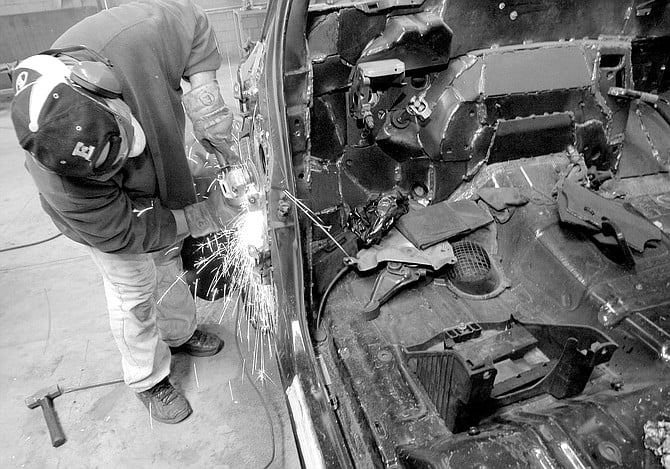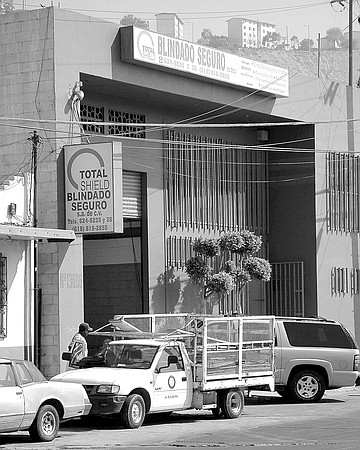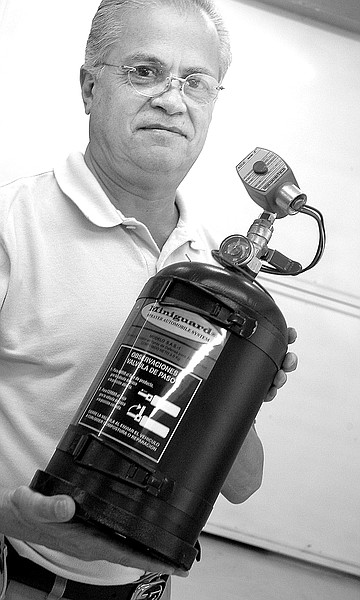 Facebook
Facebook
 X
X
 Instagram
Instagram
 TikTok
TikTok
 Youtube
Youtube

Colombia was the world's foremost vehicle-armoring country until about ten years ago when Mexico rose to prominence in the field. That's how Luis Cano Salazar, owner of a Mexico City-based armoring outfit called Total Shield, tells it. "When we started this business ten years ago," he explains, "there were five companies doing this in the metropolitan area of Mexico City. Now there are 90 plants in the same area. And the lack of security continues to increase."

Though Mexico has its warring drug cartels, it wasn't narcotraficantes who fueled Mexico's rise to number one in vehicle armoring. It was the twin crimes of armed robbery and kidnapping that began to skyrocket in Mexico City about a decade ago.

The kidnapping phenomenon in Mexico City has been documented in news stories and in movies such as Man on Fire. Lloyds of London and other carriers do a brisk business in Mexico selling kidnapping insurance. Less known, but much more common, is the rash of street-side armed robberies plaguing the capital city of Mexico. "There are more than 100 armed robberies reported a day in Mexico City," explains Cano Salazar.
The usual method, he explains, is to spot an expensive car stopped at a light or stuck in Mexico City's legendary traffic. "Then they walk up to the car and they have a pistol, generally a 9-millimeter or a .45, either inside a jacket or inside a folded newspaper. When they get to the car, they pull out the pistol, point it at the driver, and demand money. This kind of armed robbery in Mexico City is a bigger worry than kidnapping."
Cano Salazar, an engineer, owned a business that sold the high-strength ballistic steel used in the armoring process when the kidnapping/armed robbery culture began to reach epidemic proportions in the distrito federal of Mexico about a decade ago. Seeing an opportunity, he morphed his business into an armoring company, opening a plant inside of Mexico City that he directs and one just outside of the capital under the direction of his son, Luis Cano Ledezma.
A bright-eyed man in his mid-50s, Cano Salazar sits on a leather couch in Total Shield's Tijuana office, which is run by his nephew, Carlos Guerrero, who sits behind a desk in a corner of the office. Next to Cano Salazar sits his son Cano Ledezma. The two of them have just driven the 3000 kilometers north from Mexico City — in an armored Suburban — to check on their plant in Colonia Buena Vista, about four miles east of the San Ysidro crossing, south of the river. The Cano family opened this office two years ago. They marketed the idea and put together a list of customers until about five months ago, when they began armoring vehicles for wealthy tijuanenses. The deafening noise of metal being ground, welded, and hammered comes in through windows on the office wall that look down on the workshop below, where a dozen craftsmen are busy armoring four vehicles. They're all heavy, V-8- powered trucks: three SUVs and one pickup. "You can put armor on any vehicle," Cano Salazar says, "but you shouldn't. We look for cars which have disc brakes on all four wheels, strong suspension systems, and big engines because we put a lot of weight on the car. For a Suburban in level-three armoring, for example, the minimum we put on is about 300 kilos [about 660 pounds], if we use polyethylene. But if we do everything in steel, we put 1200 kilos [about 2650 pounds] on it."
"Level three" is a reference to the thickness of armor plating that Total Shield welds onto the vehicles, as well as the thickness of the bulletproof glass. "Level three," Luis Cano Ledezma explains, "is un octavo, an eighth of an inch, thick. It will turn away any kind of handgun round, even the .44 magnum or a 9-millimeter Uzi. Level four is for defense against a rifle. It's a quarter-inch thick."
"Then we have level four- plus," his father continues, "and level five, which are for defense against military weapons. In Mexico, level five is used by the police and politicians, all the industrials, big company executives, and the wealthy families. They all request level five.
"This year," Cano Salazar continues, "because of the war, we're exporting a lot of level-five armored vehicles to Iraq. First, we sent the ones that we already had. Now, we import units into Mexico from the United States, armor them, and send them to Iraq for use by contractors and media who are doing projects there. We've done work for CNN, Fox, CBS, and NBC. Two of our cars have been attacked in Iraq, and the occupants weren't hurt."
Total Shield also offers levels six and seven armoring, though they're not available commercially. "The narco police use them. They can stop armor-piercing bullets. Only 1 percent of our business is level six and seven."
The Canos estimate that 70 percent of Total Shield's business in Mexico City is level-three armoring. "It's the most popular there," Cano Ledezma explains, "because the biggest fear is the street robberies, which are always done with a handgun."
"But in Tijuana," Cano Salazar explains, "kidnapping is the bigger fear. Some of our customers have already had attempts made to kidnap them, and they're afraid. They want to prevent it from happening again. And with kidnapping, you're often talking about the AK-47 and other military rifles."
"That's why," Guerrero adds, "we sell more level four, four-plus, and five than level three in Tijuana. Seventy percent of our sales here are level four and up."
Only the upper class and the uppermost of the upper-middle class can afford to armor their cars. Asked what it costs, Cano Ledezma answers, "It depends. There are a lot of different combinations. There's all steel, which is the cheapest. Then, there's steel and high-density polyethylene. The same Suburban, level three, can go anywhere from $28,000 to $40,000, depending on the combination you decide on. Then there are extras you can add on top of that."
Cano Salazar continues, "Intercoms, to talk with the person outside of the car without opening the car, are one option. Another is a loudspeaker to make loud sirens or noises to scare away the robber or kidnapper. Then there are pepper-gas sprayers. And we offer run-flats, which are polymer-lined tires that can go 80 kilometers at 80 kilometers per hour after being punctured."
"Windows that you can roll up and down are another option," Cano Ledezma adds. "And there are systems that drop oil and nails on the road if someone is following you. There are GPS, oxygen, and communication systems. There's even a system out there, though we don't offer it, which has a flamethrower you can use to burn the robber who comes to the window."
"But the most popular right now," Cano Salazar says, "is the pepper-gas system. That's about $1500."
The Canos decline to reveal the names of any of their customers, though they say the list includes well-known singers, actors, and politicians.
Drug traffickers? Guerrero answers, "We could be doing business with those people, but there's no way we could know. All the customer is required to present is identification, a valid address, and their RFC [Registro Federal de Causantes, equivalent to U.S. Social Security number]."
Asked whether their products have passed real-world tests, Cano Salazar brings up the two cars in Iraq that repelled attacks, though he admits he hasn't seen them to see how well they performed. "Also," he adds, "there was a case in Mexico City with a very important person who had a level-three armored vehicle. He was driving one day when two vehicles blocked him in and forced him to stop. They threatened him immediately with a 9-millimeter handgun. He didn't open the car so they shot six rounds; four in the windshield and two in the side window. The victim called the police on his cell phone, and they arrived just as the secuestadores — the kidnappers — tried to cut the roof with an ax, which they couldn't do. When the police got there, the kidnappers left their vehicles and ran. The man in the car, who was 80 years old, wasn't hurt. But he said the impact of the bullets on the glass was deafening."


Colombia was the world's foremost vehicle-armoring country until about ten years ago when Mexico rose to prominence in the field. That's how Luis Cano Salazar, owner of a Mexico City-based armoring outfit called Total Shield, tells it. "When we started this business ten years ago," he explains, "there were five companies doing this in the metropolitan area of Mexico City. Now there are 90 plants in the same area. And the lack of security continues to increase."

Though Mexico has its warring drug cartels, it wasn't narcotraficantes who fueled Mexico's rise to number one in vehicle armoring. It was the twin crimes of armed robbery and kidnapping that began to skyrocket in Mexico City about a decade ago.

The kidnapping phenomenon in Mexico City has been documented in news stories and in movies such as Man on Fire. Lloyds of London and other carriers do a brisk business in Mexico selling kidnapping insurance. Less known, but much more common, is the rash of street-side armed robberies plaguing the capital city of Mexico. "There are more than 100 armed robberies reported a day in Mexico City," explains Cano Salazar.
The usual method, he explains, is to spot an expensive car stopped at a light or stuck in Mexico City's legendary traffic. "Then they walk up to the car and they have a pistol, generally a 9-millimeter or a .45, either inside a jacket or inside a folded newspaper. When they get to the car, they pull out the pistol, point it at the driver, and demand money. This kind of armed robbery in Mexico City is a bigger worry than kidnapping."
Cano Salazar, an engineer, owned a business that sold the high-strength ballistic steel used in the armoring process when the kidnapping/armed robbery culture began to reach epidemic proportions in the distrito federal of Mexico about a decade ago. Seeing an opportunity, he morphed his business into an armoring company, opening a plant inside of Mexico City that he directs and one just outside of the capital under the direction of his son, Luis Cano Ledezma.
A bright-eyed man in his mid-50s, Cano Salazar sits on a leather couch in Total Shield's Tijuana office, which is run by his nephew, Carlos Guerrero, who sits behind a desk in a corner of the office. Next to Cano Salazar sits his son Cano Ledezma. The two of them have just driven the 3000 kilometers north from Mexico City — in an armored Suburban — to check on their plant in Colonia Buena Vista, about four miles east of the San Ysidro crossing, south of the river. The Cano family opened this office two years ago. They marketed the idea and put together a list of customers until about five months ago, when they began armoring vehicles for wealthy tijuanenses. The deafening noise of metal being ground, welded, and hammered comes in through windows on the office wall that look down on the workshop below, where a dozen craftsmen are busy armoring four vehicles. They're all heavy, V-8- powered trucks: three SUVs and one pickup. "You can put armor on any vehicle," Cano Salazar says, "but you shouldn't. We look for cars which have disc brakes on all four wheels, strong suspension systems, and big engines because we put a lot of weight on the car. For a Suburban in level-three armoring, for example, the minimum we put on is about 300 kilos [about 660 pounds], if we use polyethylene. But if we do everything in steel, we put 1200 kilos [about 2650 pounds] on it."
"Level three" is a reference to the thickness of armor plating that Total Shield welds onto the vehicles, as well as the thickness of the bulletproof glass. "Level three," Luis Cano Ledezma explains, "is un octavo, an eighth of an inch, thick. It will turn away any kind of handgun round, even the .44 magnum or a 9-millimeter Uzi. Level four is for defense against a rifle. It's a quarter-inch thick."
"Then we have level four- plus," his father continues, "and level five, which are for defense against military weapons. In Mexico, level five is used by the police and politicians, all the industrials, big company executives, and the wealthy families. They all request level five.
"This year," Cano Salazar continues, "because of the war, we're exporting a lot of level-five armored vehicles to Iraq. First, we sent the ones that we already had. Now, we import units into Mexico from the United States, armor them, and send them to Iraq for use by contractors and media who are doing projects there. We've done work for CNN, Fox, CBS, and NBC. Two of our cars have been attacked in Iraq, and the occupants weren't hurt."
Total Shield also offers levels six and seven armoring, though they're not available commercially. "The narco police use them. They can stop armor-piercing bullets. Only 1 percent of our business is level six and seven."
The Canos estimate that 70 percent of Total Shield's business in Mexico City is level-three armoring. "It's the most popular there," Cano Ledezma explains, "because the biggest fear is the street robberies, which are always done with a handgun."
"But in Tijuana," Cano Salazar explains, "kidnapping is the bigger fear. Some of our customers have already had attempts made to kidnap them, and they're afraid. They want to prevent it from happening again. And with kidnapping, you're often talking about the AK-47 and other military rifles."
"That's why," Guerrero adds, "we sell more level four, four-plus, and five than level three in Tijuana. Seventy percent of our sales here are level four and up."
Only the upper class and the uppermost of the upper-middle class can afford to armor their cars. Asked what it costs, Cano Ledezma answers, "It depends. There are a lot of different combinations. There's all steel, which is the cheapest. Then, there's steel and high-density polyethylene. The same Suburban, level three, can go anywhere from $28,000 to $40,000, depending on the combination you decide on. Then there are extras you can add on top of that."
Cano Salazar continues, "Intercoms, to talk with the person outside of the car without opening the car, are one option. Another is a loudspeaker to make loud sirens or noises to scare away the robber or kidnapper. Then there are pepper-gas sprayers. And we offer run-flats, which are polymer-lined tires that can go 80 kilometers at 80 kilometers per hour after being punctured."
"Windows that you can roll up and down are another option," Cano Ledezma adds. "And there are systems that drop oil and nails on the road if someone is following you. There are GPS, oxygen, and communication systems. There's even a system out there, though we don't offer it, which has a flamethrower you can use to burn the robber who comes to the window."
"But the most popular right now," Cano Salazar says, "is the pepper-gas system. That's about $1500."
The Canos decline to reveal the names of any of their customers, though they say the list includes well-known singers, actors, and politicians.
Drug traffickers? Guerrero answers, "We could be doing business with those people, but there's no way we could know. All the customer is required to present is identification, a valid address, and their RFC [Registro Federal de Causantes, equivalent to U.S. Social Security number]."
Asked whether their products have passed real-world tests, Cano Salazar brings up the two cars in Iraq that repelled attacks, though he admits he hasn't seen them to see how well they performed. "Also," he adds, "there was a case in Mexico City with a very important person who had a level-three armored vehicle. He was driving one day when two vehicles blocked him in and forced him to stop. They threatened him immediately with a 9-millimeter handgun. He didn't open the car so they shot six rounds; four in the windshield and two in the side window. The victim called the police on his cell phone, and they arrived just as the secuestadores — the kidnappers — tried to cut the roof with an ax, which they couldn't do. When the police got there, the kidnappers left their vehicles and ran. The man in the car, who was 80 years old, wasn't hurt. But he said the impact of the bullets on the glass was deafening."
Comments